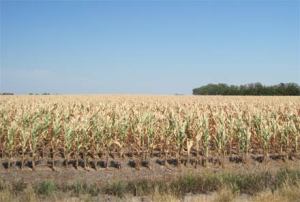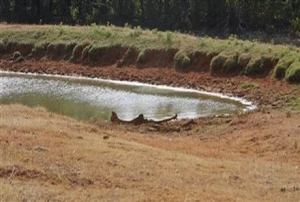Drought
Weaponisation and Chemtrails
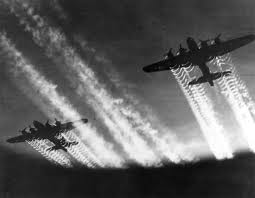
Geoengineering research began as a war tactic in the 1940s for the US and the Soviet Union during the Cold War. During the Vietnam War, the US used geoengineering to flood certain areas. Then in 1976, 85 countries signed the U.N. Convention on the Prohibition of Military of Any Other Hostile Use of Environmental Modification Techniques.

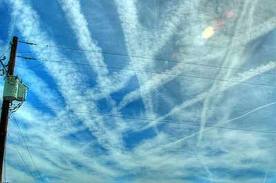
The Environmental Modification Convention generally prohibits weaponising geoengineering techniques. However, this does not eliminate the risk. Geoengineering techniques may serve as weapons of mass destruction, creating droughts or famines designed to destroy or disable an enemy.

They could also be used simply to make battlefield conditions more favourable to one side or the other in a war (such as in Operation Popeye). For example, laser-guided weapons are confounded by clouds, and thus switching off cloud machines would favour forces using such weapons, and switching them on would favour ground forces defending against them.

Whilst laws or treaties may prevent the manipulation of the climate as a weapon of war,it could be argued that geoengineering is itself a manipulation, and thus destroying or disabling the geoengineering structures is not prohibited. A new legal framework may be necessary in the event that large-scale geoengineering becomes established.
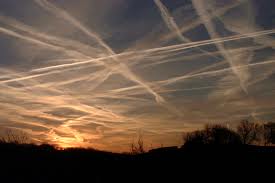
Carnegie’s Ken Caldeira said, “It will make it harder to achieve broad consensus on developing and governing these technologies if there is suspicion that gaining military advantage is an underlying motivation for its development…” http://en.wikipedia.org/wiki/Geoengineering
http://newsworldwide.wordpress.com/2011/08/07/geoengineeringchemtrail-
—————————————————————————————
DROUGHT
Drought is a direct result of a chain of events which cause any weather pattern to be disrupted.

We can point blame in so many directions but it does not make the necessary changes to reverse the dry conditions
 Texas right now is in a very bad way in the drought monitor. Billions have been lost to the economy as farms and ranches are feeling the effects as the earth cracks and all plant life dies.
Texas right now is in a very bad way in the drought monitor. Billions have been lost to the economy as farms and ranches are feeling the effects as the earth cracks and all plant life dies.I remember just a handful of years ago we had a winter rain that flooded the death valley area!
.
Suddenly the seeming dead landscape came to life with flowers that were dormant for century’s.
When the blocks are removed rain happens so naturally! Results are so dramatic and life changing.
--------------------------------------------------------------------------------------------------------------
South Central Drought Costing Billions of Dollars
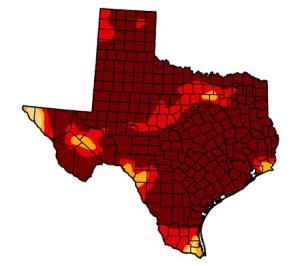
The drought costs in the parched south-central states continues to rise. Minuscule amounts of rain combined with record hot summer temperatures has resulted in billions of dollars in agricultural losses. Although some rain has been falling in the region over the last several days, it won’t be nearly enough to put much of a dent in the current drought.
Maps: Current radar
Early estimates of losses in the three states of Texas, Kansas and Oklahoma combined are more than 8 billion dollars and this figure is likely to rise. Below is a closer look at each state showing the preliminary estimates of crop and livestock losses.
See: NOAA report on record-breaking summer heat
Texas – $5.2 billion
|
Cotton farmers in the Lubbock area have abandoned their fields due to a lack of rainfall. Ranchers have had to cull there herds or pay for higher feeding costs, including relocation of cattle to other states for grazing.
Kansas – $1.7 billion
The northern periphery of the worst drought conditions in the south-central states is Kansas. Officials with the Kansas Department of Agriculture told the Associated Press that the state’s prolonged drought is costing an estimated 1.7 billion dollars in major crop losses. The agency said Wednesday it based the estimates on a comparison of current production forecasts and average historic production.Near two-thirds of the state are in moderate to exceptional drought as of September 13. The worst drought conditions are in south-central and southwest Kansas.
Oklahoma – $1.6 billion
In between Texas and Kansas lies Oklahoma, where preliminary estimates by Oklahoma State University’s Division of Agricultural Sciences and Natural Resources put agricultural losses at 1.6 billion dollars in the state. This figure includes both losses to crops and livestock.“These estimates most likely represent a lower end of the overall impact, as we have not yet accounted for off-farm impacts to farm suppliers as producers try to minimize costs, or reduced recreational and residential use because of lower lake levels, water-use restrictions and the like,” said Dave Shideler, OSU Cooperative Extension agricultural economist.
As of September 13, almost 93 percent of the Sooner State was in extreme to exceptional drought. These are the two highest categories on the U.S. Drought Monitor report.
http://www.weather.com/outlook/weather-news/news/articles/drought-south-central-cost_2011-09-15
----------------------------------------------------------------------------------------------------------
TEXAS What is Needed To End Drought Conditions
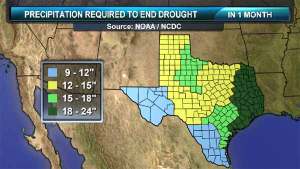
Since late last week, some much need rain has been falling across portions of Texas. For some cities, the rain totals accumulated in a few days are greater than what they have seen in many months! The table below displays rain totals over the last several days compared to the length of time you have to go back to see similar totals.
| Midland | 1.59″ Sept. 14 – 16 | Received more rain in these 3 days than the previous 360 days combined! |
| Waco | 2.13″ Sept. 18 | This is more rain than the previous 120 day combined (2.12″ May 21-Sept. 17) |
| San Antonio | 2.79″ Sept. 16-18 | More rain in 3 days than the period from May 13-Sept. 15 combined. |
| Houston (Hobby) | 1.50″ Sept. 17-19 | Equals the rain total from July 29 through August 16. |
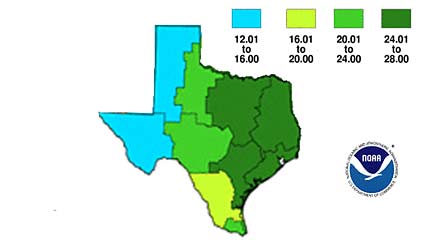
Although the one to three inch rain amounts on the list above are respectable, you can think of it as a drop in the bucket. Much more rain is needed to even put a dent in this historic drought. After all, nearly 88 percent of the Lone Star State is in exceptional drought, the worst category on the U.S. Drought Monitor.
Exactly how much rain is needed to break the drought? Check out the maps below. The first map below shows the rain amounts needed in one month to end the current drought. The green shadings indicate 15 to as much as 24 inches is needed in a single month!
The second map below uses perhaps a more realistic time period of 6 months. The darkest green shading on the second map shows that 24 to 28 inches of rain is needed in the next 6 months to end the current drought!
According to Senior Meteorologist Stu Ostro (Find him on Facebook | Twitter), “One of the primary ways to make a more significant dent in the drought in the southern Plains would be a large, wet tropical storm to move up across the region, like Lee did, but farther west. However, the pattern is very unconducive to that happening.”
http://www.weather.com/outlook/weather-news/news/articles/rain-needed-end-texas-drought_2011-09-19
